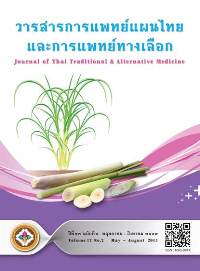Chemical Quality of Artocarpus lacucha Heartwood
Main Article Content
Abstract
The objectives of this study were to conduct a qualitative chemical analysis of Artocarpus lacucha heartwood (lakoocha or kaen mahad) using thin-layer chromatography (TLC), to develop the analytical method for determining active principle content, and to determine the amount of active ingredient in lakoocha heartwood. One gram of powdered drug was refluxed with methanol, then a TLC analysis was performed on silica gel GF254, and chloroform-methanol (4:1) was used as mobile phase. The plate was examined under ultraviolet light (254 and 365 nm wavelength) and visible with anisaldehyde-sulfuric acid reagent. The spot of oxyresveratrol appeared at Rf value of 0.75. An analytical method for oxyresveratrol content using ultra-performance liquid chromatography (UPLC) was developed. Sample preparation was undertaken by refluxing 300 mg of powdered drug in 50 ml of methanol for 60 min., filtering and evaporating until dry. The residue was redissolved and adjusted with 50% methanol to 100 ml; 3 µl of sample solution was injected to the chromatographic system consisting of BEH C18 column, 2.1×50 mm, 1.7 µm and 20% methanol as the mobile phase. The flow rate was set at 0.7 ml/min. Detection was conducted on UV326 nm. This method had been validated. Linearity was established for the oxyresveratrol concentration range of 0.06–0.42 mg/ml with a coefficient of determination (R2) value of 0.9998. Recovery was in the range of 95.75–100.36%. The limit of detection (LOD) and the limit of quantitation (LOQ) were 0.005 และ 0.017 mg/ml, respectively. The oxyresveratrol analysis of 10 samples of Artocarpus lacucha heartwood showed that the amounts of this compound were in the range of 0.64–13.67% w/w, a high variation among all samples. Therefore, chemical quality control by determining the amount of active principle is important. The result of this study could be used for quality control of this kind of medicinal plant.
Article Details
References
2. นันทวรรณ บุณยะประภัศร, อรนุช โชคชัยเจริญพร. สมุนไพรไม้พื้นบ้าน (3). พิมพ์ครั้งที่ 1. กรุงเทพฯ: บริษัท ประชาชน จำกัด; 2542. หน้า 724-6.
3. Sambhandharaksa C, Ratanachai T. Pharmacognostical and phytochemical studies of Artocarpus lakoocha Roxb. J Natl Res Counc Thailand. 1962;3:245-55.
4. Sritularak B, De-Eknamkul W, Likhitwitayawuid K. Tyrosinase inhibitors from Artocarpus lakoocha. Thai J Pharm Sci. 1998;22:149-55.
5. Povichit N, Phrutivorapongkul A, Suttajit M, Leelapornpisid P. Antiglycation and antioxidant activities of oxyresveratrol extracted from the heartwood of Artocarpus lakoocha Roxb. Maejo Int. J. Sci. Technol. 2010;4(3):454-61.
6. Singhatong S, Leelarungrayub D, Chaiyasut C. Antioxidant and toxicity activities of Artocarpus lakoocha Roxb. heartwood extract. J Med Pl Res. 2010;4(10):947-53.
7. Palanuvej C, Issaravanich S, Tunsaringkarn T, Rungsiyothin A, Vipunngeun N, Ruangrungsi N, Likhitwitayawuid K. Pharmacognostic study of Artocarpus lakoocha
heartwood. J Health Res. 2007;21(4):257-62.
8. Maneechai S, Likhitwitayawuid K, Sritularak B, Palanuvej C, Ruangrungsi N, Sirisa-ard P. Quantitative analysis of oxyresveratrol content in Artocarpus lakoocha and “Puag-Haad”. Med Princ Prac. 2009;18:223-7.
9. ดวงเพ็ญ ปัทมดิลก อภิรักษ์ ศักดิ์เพ็ชร พีรธรรม เทียมเทียบรัตน์ สิริกาญจน์ ธนอริยโรจน์ ประถม ทองศรีรักษ์. รายงานฉบับสมบูรณ์โครงการวิจัย เรื่อง การพัฒนาวิธีวิเคราะห์ปริมาณสารสำคัญในมะหาด. สถาบันวิจัยสมุนไพร กรมวิทยาศาสตร์การแพทย์. ปีงบประมาณ 2557.
10. Yokotsuka K, Okuda T. Light-induced isomerization of trans-resveratrol to cis-resveratrol in must and wine during fermentation and storage. J ASEV Jpn. 2011; 22(1):16-21.

